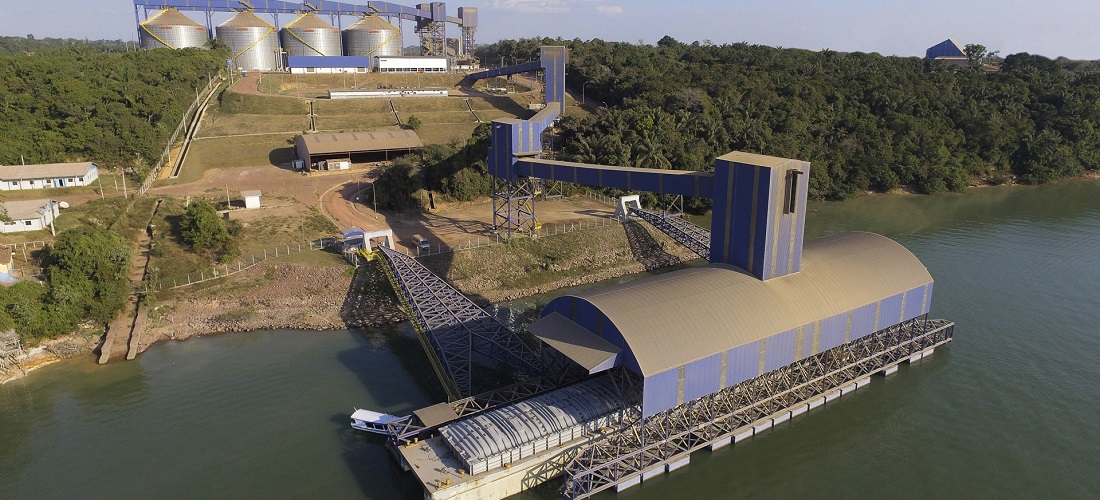
Hidrovias do Brasil wants to double grain movement
Aug, 23, 2019 Posted by Sylvia SchandertWeek 201935
With an eye on the strong growth of exports through the ports of Arco Norte in recent years, Hidrovias do Brasil, controlled by the Pátria fund, has sought to expand its presence in the region. The comfortable cash position also allows the company to map opportunities in the southern logistics corridor, where it sees room for consolidation, and in geographies where it does not yet operate. Proof of this is the recent acquisition of a port lease in Santos (SP), which will be part of a future salt movement project from Rio Grande do Norte (RN).
In an interview with Broadcast (Grupo Estado’s real-time news system), Hidrovias do Brasil’s vice president of finance, Fabio Schettino, says the plans involve doubling the total grain handling capacity to 13m tons, expanding the northern operation.
Currently, operations in the region include a Cargo Transshipment Station in Miritituba (PA), where pusher and barge convoys are loaded with export goods arriving by truck via the BR-163 and leaving towards the private terminal of use of the company in Vila do Conde (PA). In July, the company reached full monthly capacity for the first time in the region with the transition from soybean to safrinha corn. “Our terminal can live with both corn and soy, so it doesn’t have to close the soy program to get into corn,” he said. “In the crop transition, this is very important in terms of competitiveness.”
As the main investments in its own infrastructure have already been made, Hidrovias do Brasil estimates that the project would require between R$700m and R$750m, about half of the invested to date in the region. The final decision on the amount may take place next year so that disbursements begin in 2022 or 2023, after the volumes anticipated in long-term contracts (maximum operating capacity, including long-term contracts and those closed each season) have already been fully achieved.
The executive also points out that the flow of cargo through the North should increase if the federal projects of Ferrogrão and the BR-163 concession come to life. According to him, recent government efforts to move ahead with paving the BR-163 and coordinate road traffic have already impacted monthly freight prices between Sorriso (MT) and Miritituba (PA), and contributed to the fall from R$260/t to R$190/t. “Ferrogrão is able to reduce (freight) by another R$60 to R$70 per ton. If there is a railroad in Brazil that is economically viable today, it is called ‘Ferrogrão’. And that’s because of the volume of cargo: Mato Grosso produces 60m tons of grain per year,” he evaluates.
On another front, Hidrovias do Brasil is also aware of the opportunities for cargo transportation in the Matopiba region – the agricultural frontier between the states of Bahia, Maranhão, Tocantins, and Piauí. An example is the Pedral do Lourenço overturning works, which will enable the navigation of the Tocantins River between Marabá and Baião (PA) throughout the year. The company already owns land in Marabá where it intends to install a Cargo Transshipment Station to take advantage of the future waterway that will lead to Vila do Conde. “We are now resuming the environmental licensing process for this terminal,” said Schettino.
Acquisition in Santos
Outside the North logistics corridor, the company won a strategic position this month in the Port of Santos (SP). In a federal auction, Hidrovias do Brasil acquired the lease of STS20 area for R$112.5m, intended for the movement and storage of fertilizers and salts in the region of Outeirinhos.
The idea is that the terminal will be part of the salt logistics that is being structured with Salinor in Rio Grande do Norte. Regarding fertilizers, the executive pointed out that São Paulo consumes 4m tons of the product per year, with 70% being imported by Santos. “It has everything to do with our business,” he said. “And nothing prevents it from also being a fertilizer route to other regions.” The company is expected to move up to 600,000 tons of fertilizer this year through the North Arc.
Regarding the Southern region, Hidrovias do Sul sees room for organic and inorganic growth through acquisitions. “I think the strategy is to consolidate and gain market share,” says the CFO.
The business that the company operates in this corridor includes the Paraná-Paraguay waterway (transportation of iron ore, grains, and fertilizers), the Uruguay River (pulp), and the Montevideo Terminal.
Source: Terra


